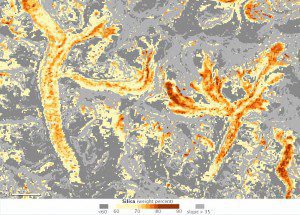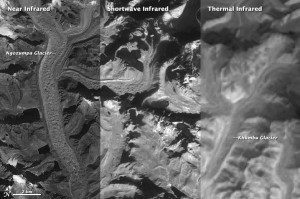
In this ASTER satellite image, rock debris with higher silica content (granite) is shown in shades of orange and red, while debris with less silica (gneiss) appears as shades of yellow.
Many Earth observation satellite sensors are tuned to be sensitive to specific parts or bands of the light spectrum that are invisible to human eyes.
The Advanced Spaceborne Thermal Emission and Reflection Radiometer (ASTER) instrument”built by Japan's Ministry of Economy, Trade and Industry for NASA's Terra satellite”observes six bands in the shortwave infrared (just beyond red light at 1 to 2.5 microns) and five in the thermal infrared (3 to 12 microns). The Enhanced Thematic Mapper Plus (ETM+) and Operational Land Imager (OLI) on Landsats 7 and 8 also have bands in the shortwave and thermal infrared.

This image shows how NASA's ASTER satellite views Nepal's Khumbu and Ngozumpa glaciers in three different spectral bands. The near-infrared band appears crisper than the others, because ASTER has the highest spatial resolution at that band. ASTER's resolution is 15 meters per pixel in the near-infrared, 30 meters per pixel in the shortwave infrared and 90 meters per pixel in the thermal infrared.
NASA scientist Kimberly Casey has mined data from numerous spectral bands to generate maps of debris on key glaciers around the world. Her maps not only discriminate between dirty and clean ice; they describe the composition of the debris. This is important because the type of debris can affect the melting rate of glacial ice and can influence how it responds to climate change.
The ability to observe different wavelengths is critical because different types of debris”rocks from landslides, volcanic ash, airborne dust, or polluting soot”leave unique spectral fingerprints that satellites can measure. By analyzing ASTER data, for instance, Casey mapped the silica content of Nepal's Khumbu and Ngozumpa glaciers.
Image courtesy of NASA.

